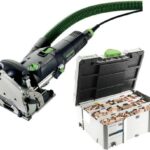Straining paint is a process that involves filtering out any...
Which Zinsser Primer should I be using?
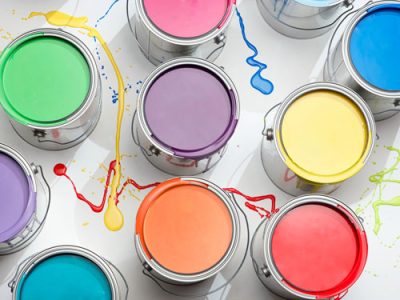
Zinsser paint primers – you have probably heard of them before and wondered what, where and how do they work? The aim in this blog is to give you a quick overview as to what Zinsser primer you should be using and where best to use it.
Firstly what is a primer anyway?
A primer or undercoat is a preparatory coating put on materials before painting. Priming ensures better adhesion of paint to the surface, increases paint durability, and provides additional protection for the material being painted.
- Covers imperfections such as areas of your wall that may have been patched or repaired.
- Blocks and conceals stains so they don’t bleed through your newly painted finish.
- Provides a uniform surface for your paint to stick to. (Better adhesion = a longer-lasting paint job.)
- Creates a uniform base for a smooth, seamless paint application, so you can get the job done in fewer coats.
- Neutralizes the color of your surface so when new paint is applied, the truest, most brilliant, color shines through.
When do I need to use a primer?
- When switching from a higher sheen to a lower sheen finish, like from semi-gloss to eggshell.
- Switching from a dark color to a lighter one.
- If your walls have been repaired or patched.
- If you’re painting a humid area like a bathroom, which is more susceptible to mildew and leaching.
- If your wall has stains that you want to block (like water spots from a bathroom leak or smoke damage from a fire in a kitchen).
- When painting unfinished wood trim or other very porous surfaces.
What are the three main types of primer?
- Shellac Based Primer-Sealer
- Water Based Primer-Sealer
- Oil Based Primer-Sealer
Shellac Based Primer –
Shellac has been used for centuries to seal wood and other surfaces. Good for interior paint jobs, shellac-based primers are possibly the best stain-blocking primers, working well on severe water and smoke damage to walls and surfaces — they even seal in smells from smoke damage. They also are excellent at preventing normal water, rust and smoke stains, as well as wood tannins from bleeding through new paint. They work well on wood, metal, plaster, and even plastic, and are fast drying and highly adhesive. They also can be used with both oil-based and latex paints.
The drawback to using shellac-based primers is that they are not as versatile as latex or oil and they give off more fumes. They require that you use denatured alcohol to thin them and clean applicators.
Water Based Primer –
Water-based Primers are ideal when prepping unfinished drywall for painting. They are less likely to peel or crack and are more flexible and fast drying than oil-based primers. On top of this they are great for priming soft wood (such as pine), brick or even concrete.
Water-based primers even out patched or repaired surfaces very well. They can also cover and seal in previous minor stains from smoke, lipstick, crayon, etc., but are not as effective at covering stains as oil- and shellac-based primers.
Due to the water-based type, clean-up is super easy and most primers have low- or no-VOC formulas, which makes them a healthier alternative to oil-based and shellac primers.
Oil Based Primer –
Oil-based primers and paints have been an industry standard for decades. These primers work with both oil paints and latex paints, making them very versatile and applicable to a wide variety of surfaces. Wood (painted or unpainted), steel and other metals, and surfaces with existing paint, such as interior and exterior walls are ideal surfaces for oil-based primers.
Many oil-based primers are good “stain killers” and prevent stains from showing through your new coats of paint. They are good for blocking stains on your walls from ink, nicotine and water.
Oil-based primers are ideal for interior and exterior unfinished or bare wood because they seal the porous surface of wood, enabling the coat of paint to better cover the surface. They stop tannins, released from woods, such as cedar or redwood, from bleeding through the surface of the paint. They also prevent or slow down paint peeling, cracking and blistering.
A drawback of oil-based primers (as with oil-based paints), they are often slow-drying and release high amounts of volatile organic compounds (VOCs), which can be harmful to people in high concentrations and with prolonged exposure. They also require that you use harsh thinners and solvents to clean brushes and applicators, and have to be disposed of carefully and properly. Oil-based primers should not be used on masonry.
Zinsser’s Top Primers –
Zinsser B-I-N Primer Sealer (Shellac Based) – Zinsser B-I-N is the original Zinsser stain-blocking Primer-Sealer. Introduced in 1946 and still the industry standard, with 100% white-pigmented shellac it blocks the worst stains, seals in the toughest odors and bonds tightly to glossy dense surfaces. B-I-N seals in knots and sap streaks, grease stains, fire odor, and seals new wood. No other primer performs as effectively or dries and cures as quickly (45 minutes to touch dry).
- Shellac resin in B-I-N® seals pet, smoke and musty odors permanently and completely
- For interior and spot exterior use
- Covers and seals rust, greasy, oily areas and spackle repairs
- Outstanding for glossy surfaces like cabinets, doors, vinyl trim and metal
- Completely seals and covers the toughest stains to prevent bleeding through new paint
- Sticks to surfaces without sanding
- Touch dry in 45 minutes; recoat in 2 hours
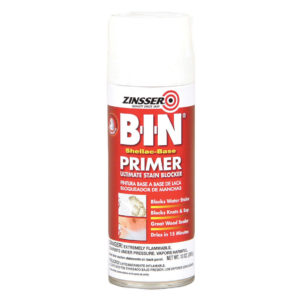
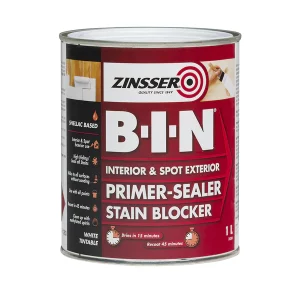
Zinsser Cover Stain Primer Sealer (Oil Based) – Cover Stain is a unique oil-based primer, formulated to dry fast and yet stay flexible and durable enough to work on a variety of interior/exterior surfaces. It is breathable, performance well on exterior surfaces and is an effective stain barrier. For painters who prefer and need oil-base performance, it will provide top quality results and has great application properties.
- Primer-sealer for interior and exterior
- Penetrates and seals porous surfaces such as wood siding, unfinished furniture, shelving, and spackled areas
- Covers exterior graffiti
- Is ideal for use under texture and popcorn finishes
- Blocks cedar & redwood bleed
- Adheres to hard-to-paint surfaces without sanding
- Fast dry time; recoat in 2 hours
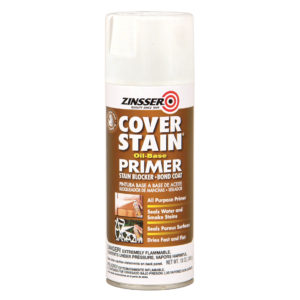
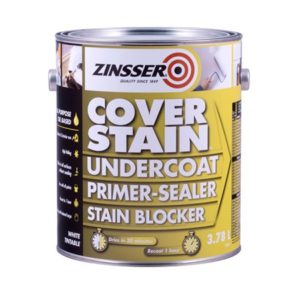
Zinsser Bulls Eye 1-2-3 Primer Sealer (Water Based) – Introduced in 1982, Bulls Eye 1-2-3 was the first water-base primer and bond coat and remains Zinsser’s most popular primer. There’s a reason Rust-Oleum Zinsser Bulls Eye 1-2-3® Water-Base Primer is our most popular primer. This premium, whole-house primer-sealer provides outstanding performance indoors and out, with great flow and leveling and a flexible, acrylic formula. It sticks to the glossiest finishes and blocks difficult stains from appearing on your interior and exterior painted surfaces.
- Creates a mold and mildew resistant film
- For interior and exterior use
- Sticks to all surfaces without sanding
- Seals stains, graffiti and tannin bleed
- Rust inhibitive – great for new metal
- Fast 1 hour dry time
- Low-odor, soap and water clean-up
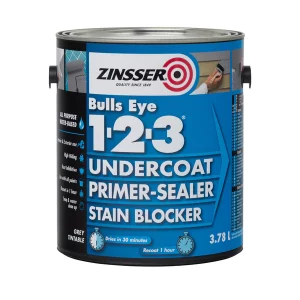
Blog Credits: Haydn Brush Company
Like every trade a plasterers tools are what makes him/her...
You asked, we answered! Due to popular demand for a...
When it comes to woodworking, metalworking, or any...




